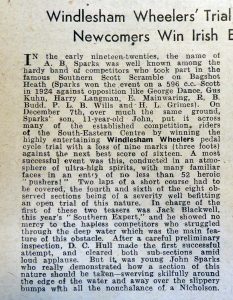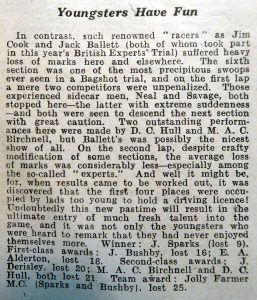
The discovery I made in October 2018 at the British Library in London is sensational. Although it was to be expected that bike trials must have originated in Great Britain, the motherland of observed trials, no evidence had ever been found to support this. Apparently, the British had forgotten that this early cycle trial existed shortly after the war. They then introduced bike trials in the 1980s as ‘Trialsin’ by Pere Pi, who – using his Montesa business connections – prepared the Eurocup, which took place for the first time in 1982. When I visited the editorial office of TRIALS & MOTOCROSS NEWS in Morecambe in March 1981 (the editorial office was located on the upper floor of a hat shop), which also published BMX NEWS magazine, they knew nothing about bike trials and were surprised when I showed them photos from Germany.

The organiser of the Windlesham Wheelers Trial was no stranger. I need to backtrack a little: the Scott Trial in the Yorkshire Dales, first held in 1914, is now a classic motorcycle trials event, which, like the Scottish Six Days Trial in Scotland, first held in 1909, still exists today. Both events were famous even in the past. The Scott Trial was and is notorious for its selective nature, as it is also a race against time on a very difficult course. Only the first rider to cross the finish line receives no time penalties – for every minute later at the finish, there is one penalty point. Added to this are the section penalty points. 1 The Scott Trial was always a good trial, taking place in fantastic terrain, where style was important and the time trial was the icing on the cake. It is not without reason that the ‘Scott’ is considered something like the first motorcycle trial, even though the ‘Scottish’ is a few years older. The riders from this area had a reputation to match.
This led to a rivalry with riders from southern England, who were not willing to take this lying down and organised the ‘Southern Scott Trial’ in Camberley Heath, southwest of London, in 1924, on the very heathland next to Bagshot and Aldershot (well-known names in motorcycle trials) and Windlesham. Due to the completely different terrain of this hilly and sandy heathland – the Scott Trial in Yorkshire had rocky terrain with streams and greater differences in altitude – the Southern Scott Trial focused solely on time. Two laps were ridden, with a lunch break in between. There was no style scoring; the fastest rider was the winner. I mention this here because this event became the forefather of the scramble, which means something like ‘wild brawl’ or ‘wild chaos’ – the Belgians later turned this into the term motocross.
The Camberley Club was a very active association that organized numerous activities. These included the bicycle trial or pedal cycle trial held by the Windlesham Wheelers in 1947 on the heath near Bagshot. The overlap in personnel with the Southern Scott Trial is discussed in the newspaper article in THE MOTOR CYCLE, which I have translated below and reproduced in the original text (click to enlarge). This oldest known bicycle trial to date has a good chance of also being the first bicycle trial ever. In any case, the corresponding newspaper report refers to a “new pastime.” It was no small event, with 52 participants at the start. Among them were well-known names from motorcycle trials, as explained in the translated newspaper report. The gasoline shortage shortly after the war certainly contributed to these people, who were unable to pursue their beloved trial hobby on motorcycles, taking to pedals instead. The Nicholson referred to in the newspaper article is Bill Nicholson, winner of the Scott Trials in 1949, 1950, and 1951, winner of the British Experts Trial in 1950, and winner of the ACU Trials Star in 1951 and 1952.
Windlesham Wheelers‘ Trial
Translation of a newspaper article from THE MOTOR CYCLE dated 18 December 1947, p. 484.
 In den frühen 1920er Jahren war der Name A. B. Sparks der verwegenen Schar von Teilnehmern, die beim berühmten Southern Scott Scramble in der Bagshot-Heide mitfuhren, wohlbekannt (Sparks gewann die Veranstaltung von 1924 auf einer Scott mit 596 Kubikzentimetern Hubraum gegen Konkurrenten wie George Dance, Gus Kuhn, Harry Langman, E. Mainwearing, R. B. Budd, P. L. B. Wills und H. L. Grimes). Am 7. Dezember bezwang Sparks Sohn, der elfjährige John, auf praktisch demselben Gelände viele der etablierten Wettbewerbsfahrer des South East Centre, in dem er das hoch unterhaltsame Fahrrad-Trial der Windlesham Wheelers mit neun Strafpunkten (drei Füße) vor dem nächstbesten Ergebnis von 16 Punkten gewann. Es war eine überaus erfolgreiche Veranstaltung, ausgetragen in heiterster Atmosphäre und mit vielen bekannten Gesichtern in einem Starterfeld von nicht weniger als 52 heroischen „Tretern“. Zwei Runden mußten auf einer kurzen Strecke absolviert werden, deren vierte und sechste von acht beobachteten Sektionen vom Schwierigkeitsgrad her einem offenen Trial dieser Art gut zu Gesicht gestanden hätten. Die erste dieser beiden „harten Nüsse“ wurde von Jack Blackwell beaufsichtigt, dem „Southern Expert“ dieses Jahres, und der zeigte keine Nachsicht gegenüber den unglücklichen Teilnehmern, die sich durch tiefes Wasser kämpften, das das Hauptmerkmal dieses Hindernisses war. Nach einer vorherigen sorgfältigen Inspektion machte D. C. Hull den ersten erfolgreichen Versuch und bewältigte unter lautem Applaus die beiden Unterabschnitte. Aber es war der junge John Sparks, der geradezu demonstrierte, wie man eine solche Sektion angehen muß – den Rand des Wassers geschickt umfahrend und dann raus über rutschige Unebenheiten mit der ganzen Lässigkeit eines Nicholson.
In den frühen 1920er Jahren war der Name A. B. Sparks der verwegenen Schar von Teilnehmern, die beim berühmten Southern Scott Scramble in der Bagshot-Heide mitfuhren, wohlbekannt (Sparks gewann die Veranstaltung von 1924 auf einer Scott mit 596 Kubikzentimetern Hubraum gegen Konkurrenten wie George Dance, Gus Kuhn, Harry Langman, E. Mainwearing, R. B. Budd, P. L. B. Wills und H. L. Grimes). Am 7. Dezember bezwang Sparks Sohn, der elfjährige John, auf praktisch demselben Gelände viele der etablierten Wettbewerbsfahrer des South East Centre, in dem er das hoch unterhaltsame Fahrrad-Trial der Windlesham Wheelers mit neun Strafpunkten (drei Füße) vor dem nächstbesten Ergebnis von 16 Punkten gewann. Es war eine überaus erfolgreiche Veranstaltung, ausgetragen in heiterster Atmosphäre und mit vielen bekannten Gesichtern in einem Starterfeld von nicht weniger als 52 heroischen „Tretern“. Zwei Runden mußten auf einer kurzen Strecke absolviert werden, deren vierte und sechste von acht beobachteten Sektionen vom Schwierigkeitsgrad her einem offenen Trial dieser Art gut zu Gesicht gestanden hätten. Die erste dieser beiden „harten Nüsse“ wurde von Jack Blackwell beaufsichtigt, dem „Southern Expert“ dieses Jahres, und der zeigte keine Nachsicht gegenüber den unglücklichen Teilnehmern, die sich durch tiefes Wasser kämpften, das das Hauptmerkmal dieses Hindernisses war. Nach einer vorherigen sorgfältigen Inspektion machte D. C. Hull den ersten erfolgreichen Versuch und bewältigte unter lautem Applaus die beiden Unterabschnitte. Aber es war der junge John Sparks, der geradezu demonstrierte, wie man eine solche Sektion angehen muß – den Rand des Wassers geschickt umfahrend und dann raus über rutschige Unebenheiten mit der ganzen Lässigkeit eines Nicholson.
Jüngere haben ihren Spaß
 Demgegenüber hatten so berühmte „Rennfahrer“ wie Jim Cook und Jack Ballett (die beide am diesjährigen British Experts‘ Trial teilnahmen) hier und an anderen Stellen viele Strafpunkte zu beklagen. Die sechste Sektion war eine der steilsten Abfahrten, die es jemals bei einem Trial in Bagshot gegeben hat; gerade einmal zwei Teilnehmer blieben in der ersten Runde fehlerfrei. Die erfahrenen Gespannfahrer Neal und Savage kamen hier beide zum Stillstand – letzterer ganz plötzlich – und beide gingen die Abfahrt der nächsten Sektion mit großer Vorsicht an. Zwei herausragende Vorstellungen boten D. C. Hull und M. A. C. Birchnell, doch war Ballett hier vielleicht von allen am schönsten anzusehen. In der zweiten Runde gab es trotz der erschwerenden Abänderung einiger Sektionen im Durchschnitt bedeutend weniger Strafpunkte – vor allem bei den sogenannten „Experten“. Dieser Eindruck dürfte stimmen, denn als die Ergebnisse ausgewertet wurden, stellte sich heraus, daß die ersten vier Plätze von Jungens belegt wurden, die noch nicht alt genug für den Führerschein waren! Ganz ohne Zweifel wird dieser neue Zeitvertreib dem Sport letztendlich viele junge Talente zuführen und nicht nur von den Jungen war zu hören, daß sie noch nie so viel Spaß gehabt hätten. Sieger: J. Sparks (9 Strafpunkte). Preise erster Klasse: J. Bushby, 16 Strafpunkte; E. A. Alderton, 18 Strafpunkte. Preise zweiter Klasse: J. Derisley, 20 Strafpunkte; M. A. C. Birchnell und D. C. Hull, beide 21 Strafpunkte. Team-Preis: Jolly Farmer M. C. (Sparks und Bushby), 25 Strafpunkte.
Demgegenüber hatten so berühmte „Rennfahrer“ wie Jim Cook und Jack Ballett (die beide am diesjährigen British Experts‘ Trial teilnahmen) hier und an anderen Stellen viele Strafpunkte zu beklagen. Die sechste Sektion war eine der steilsten Abfahrten, die es jemals bei einem Trial in Bagshot gegeben hat; gerade einmal zwei Teilnehmer blieben in der ersten Runde fehlerfrei. Die erfahrenen Gespannfahrer Neal und Savage kamen hier beide zum Stillstand – letzterer ganz plötzlich – und beide gingen die Abfahrt der nächsten Sektion mit großer Vorsicht an. Zwei herausragende Vorstellungen boten D. C. Hull und M. A. C. Birchnell, doch war Ballett hier vielleicht von allen am schönsten anzusehen. In der zweiten Runde gab es trotz der erschwerenden Abänderung einiger Sektionen im Durchschnitt bedeutend weniger Strafpunkte – vor allem bei den sogenannten „Experten“. Dieser Eindruck dürfte stimmen, denn als die Ergebnisse ausgewertet wurden, stellte sich heraus, daß die ersten vier Plätze von Jungens belegt wurden, die noch nicht alt genug für den Führerschein waren! Ganz ohne Zweifel wird dieser neue Zeitvertreib dem Sport letztendlich viele junge Talente zuführen und nicht nur von den Jungen war zu hören, daß sie noch nie so viel Spaß gehabt hätten. Sieger: J. Sparks (9 Strafpunkte). Preise erster Klasse: J. Bushby, 16 Strafpunkte; E. A. Alderton, 18 Strafpunkte. Preise zweiter Klasse: J. Derisley, 20 Strafpunkte; M. A. C. Birchnell und D. C. Hull, beide 21 Strafpunkte. Team-Preis: Jolly Farmer M. C. (Sparks und Bushby), 25 Strafpunkte.
- ‘Oberservers will be stationed at steep slopes and water crossings,’ was first announced in 1924, when section scoring was introduced at the Scott Trial in addition to the older time scoring system; THE MOTOR CYCLE, 4 September 1924, p. 349. ↩